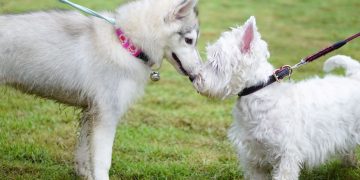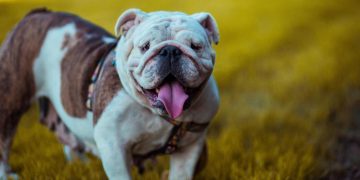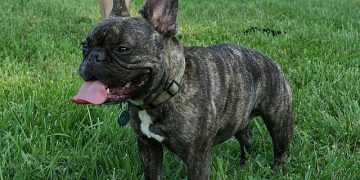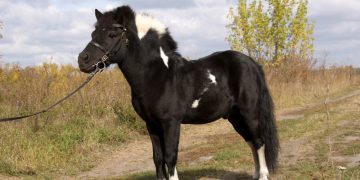Many pet owners believe that male dogs go into “heat” just like females, but this is a misconception. Unlike female dogs, male dogs do not experience estrous cycles. Instead, they remain sexually active year-round and are driven by the presence of a female in heat. However, a male dog’s reproductive behavior can be broken down into four key stages, influenced by hormonal changes and external stimuli.
This article will provide an in-depth breakdown of these four stages, shedding light on male canine reproductive instincts, behaviors, and management tips for dog owners.
Do Male Dogs Go into Heat?
Before we explore the stages, it’s essential to clarify that male dogs do not go through “heat” cycles like females. Instead, they are sexually responsive whenever a receptive female is nearby. This responsiveness can be categorized into four key behavioral phases:
- Awareness Stage – Detecting a Female in Heat
- Excitement Stage – Increased Sexual Arousal
- Mating Stage – Active Copulation Behavior
- Post-Mating Stage – Resolution and Behavioral Aftereffects
Let’s explore each of these stages in detail.
1. Awareness Stage: Detecting a Female in Heat
The first stage occurs when a male dog detects the presence of a female dog in heat. This detection is primarily driven by the pheromones released by the female during her estrus cycle.
Key Factors in the Awareness Stage
- Scent Detection: Male dogs have an extraordinary sense of smell and can detect a female in heat from miles away. The female releases pheromones (methyl p-hydroxybenzoate), signaling her readiness to mate.
- Behavioral Changes: The male may become noticeably restless, anxious, and overly focused on tracking the scent.
- Vocalization: Some males may whine, bark excessively, or even attempt to escape their enclosure in pursuit of the female.
How to Manage This Stage
- Keep your male dog securely confined if you don’t want accidental breeding.
- Use distraction techniques such as increased exercise and mental stimulation.
- If your dog is excessively anxious, consult a vet about possible behavioral interventions.
2. Excitement Stage: Increased Sexual Arousal
Once the male identifies a female in heat, he enters an excitement stage where his hormonal drive intensifies. Testosterone plays a crucial role in this phase, triggering aggressive mating behaviors.
Signs of the Excitement Stage
- Frequent Urination & Marking: The male will mark territory with urine containing pheromones to signal dominance and readiness to compete for a mate.
- Restlessness & Hyperactivity: Increased pacing, panting, and difficulty focusing on normal routines.
- Mounting Behavior: Attempting to mount objects, other dogs, or even humans.
Potential Challenges for Owners
- Increased aggression or territorial behavior around other male dogs.
- Disruptive behaviors such as persistent whining, refusing food, or excessive roaming attempts.
- The risk of unwanted mating if the male has access to the female.
Management Strategies
- Consider neutering if your dog is not intended for breeding.
- Use physical barriers to separate males from females in heat.
- Engage your dog in vigorous exercise to expend pent-up energy.
3. Mating Stage: Active Copulation Behavior
If given access to a receptive female, the male will enter the mating stage, during which copulation occurs. This process includes several distinct behaviors.
Phases of Mating
- Courtship: The male sniffs, licks, and nuzzles the female’s genital area to confirm her receptiveness.
- Mounting: The male mounts the female, aligning himself for penetration.
- The Tie: A unique canine reproductive behavior where the male and female become locked together for 5 to 30 minutes due to swelling of the bulbus glandis in the male’s penis.
Key Considerations for Owners
- If breeding is intentional, ensure the process occurs in a controlled, stress-free environment.
- If you want to prevent mating, supervision and separation are critical.
4. Post-Mating Stage: Resolution and Behavioral Aftereffects
After mating, the male may experience lingering hormonal effects that influence his behavior.
Common Post-Mating Behaviors
- Continued Interest in the Female: Even after copulation, a male may try to mate again if the female remains in estrus.
- Temporary Lethargy: Some males exhibit post-coital fatigue due to the physical exertion of mating.
- Reduced Appetite: Hormonal fluctuations may briefly affect eating habits.
How to Manage Post-Mating Effects
- Provide a quiet space for rest and recovery.
- Ensure proper hydration and nutrition.
- If unwanted mating occurs, consult a veterinarian about options, such as mismating injections for the female.
How Long Does Male Dog “Heat” Behavior Last?
Unlike females, who experience heat for 2-4 weeks, a male dog’s heightened sexual arousal can persist as long as a female in heat is nearby. Some males may remain agitated for several days to weeks if the scent lingers in the environment.
How to Minimize Long-Term Effects
- Remove lingering female pheromones by cleaning areas with enzymatic cleaners.
- Distract the male dog with play, training, or interactive toys.
- In extreme cases, medications may help reduce obsessive behaviors—consult a vet.
Should You Neuter Your Male Dog?
Neutering significantly reduces the intensity of these reproductive behaviors and prevents accidental pregnancies. Key benefits include:
✔️ Decreased aggression and territorial behaviors.
✔️ Reduced urge to roam.
✔️ Lower risk of prostate diseases and testicular cancer.
However, if you plan to breed, responsible ownership is crucial to prevent unplanned litters and ensure healthy lineage management.
Final Thoughts
While male dogs do not experience “heat” cycles like females, they go through distinct stages of sexual responsiveness when exposed to a female in estrus. Understanding these phases helps owners manage their dog’s behavior effectively and prevent unwanted mating.
Key Takeaways:
- Male dogs are always fertile but only exhibit heightened mating behaviors when a female is in heat.
- The four stages include awareness, excitement, mating, and post-mating behaviors.
- Managing a sexually excited male requires supervision, exercise, and possible neutering to curb unwanted behaviors.
By understanding these natural instincts, you can ensure responsible dog ownership while maintaining a balanced and stress-free environment for your pet.
Would you like additional details on training techniques to manage mating-related behaviors? Let me know! 🚀

























